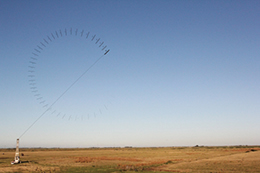| August 2013 | ||
 Print Print  Email Email |
Archive | |

| www.ibew.org |
|
 |
|

|

For four days in February 2012, three Chattanooga, Tenn., Local 175 members attached 99 rectangular-metal boxes to some transmission lines east of Knoxville that just might solve one of the thorniest problems of the American electrical grid. Foreman Cody Young and his co-workers Ryan Swafford and Jeb Tenille worked about 20 miles of 161-kilovolt transmission lines owned by the Tennessee Valley Authority. The boxes, called "discrete series reactors," promised to do something very hard in a simple, durable way: steer electrical power away from overloaded transmission lines to underutilized parts of the grid. If there is a traffic jam in a city, drivers will take other routes. Electrons, though, always take the path of least resistance, which often means some wires in transmission grids are maxed out long before the grid as a whole is. The result is the average grid operates at about 60 percent of capacity. Previous attempts to get electrons into less busy wires had been large, expensive and used lots of energy. The DSR gets all the energy it needs from the line it is clamped to and, autonomously or by remote control, can increase the impedance on a line, like squeezing a garden hose with a clamp. To make installation easier, Smart Wire Grid, the Oakland-based startup that makes the DSRs, created a special attachment for the bucket trucks. "We raised it up to the line, hinged the top over, and then closed it down with 20 bolts to secure it, and we went on to the next one," Young said. Young and company got all 99 installed in less than four days and ahead of schedule. If the DSRs work as expected, and that is still a question, carrying capacity on electrical grids could jump to 90 percent. At that level, a U.S. Department of Energy study found that up to 10 times more renewable energy production could be added to our current electrical grid without harming reliability. |

|
© Copyright 2013 International Brotherhood of Electrical Workers | User Agreement and Privacy Policy | Rights and Permissions |